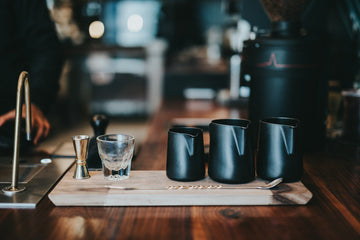Latte vs. Cappuccino - What's the difference?
The world of espresso-based drinks can be a bit bewildering, especially if you aren't familiar with the jargon used in most coffee shops. Two of the most popular espresso drinks that often get mixed up are the latte and the cappuccino. Both drinks are beloved by coffee aficionados worldwide, but what exactly is the difference between a latte and a cappuccino?
The Fundamentals
Before we delve into the specifics, it's important to know that both lattes and cappuccinos are built upon the same foundation: a shot of espresso. Espresso is a method of brewing coffee that forces a small amount of nearly boiling water under pressure through finely-ground coffee beans. The result is concentrated coffee that serves as the heart of both lattes and cappuccinos. Any of our single origin coffees can be used for espresso because, in fact, there is no such thing as an espresso bean.
Steamed Milk vs. Frothed Milk
Understanding the difference between steamed milk and frothed milk is the first step to mastering these popular espresso beverages.
Steamed Milk: Steamed milk is created by introducing hot steam into cold milk, which heats the milk and creates small, fine bubbles. The result is a velvety, creamy texture that blends seamlessly with the espresso in your latte. Steaming also brings out the natural sweetness of the milk, which can balance the robust flavors of the espresso.
Frothed Milk: Frothing, on the other hand, involves a more vigorous process that introduces a larger amount of air into the milk, creating bigger bubbles and more volume. This results in a thick, airy foam that sits on top of the espresso in a cappuccino. The layer of frothed milk adds a light and fluffy texture, contrasting nicely with the rich espresso below.
What is a Cappuccino?
Originating in Italy, the cappuccino is a classic espresso-based drink known for its balanced proportions. A traditional cappuccino is comprised of three equal parts of espresso, steamed milk, and frothed milk. This structure allows for a perfect balance of the rich and bold espresso, the creamy milk, and the light and airy froth. The frothed milk creates a luxurious texture on top.
What is a Latte?
The word 'latte' actually means 'milk' in Italian, and this offers a good hint about the nature of this beverage. A latte consists of a shot of espresso and steamed milk, with just a small amount of froth on top. The ratio of espresso to milk is typically 1:3 to 1:5, making the latte a milkier drink compared to the cappuccino. Because of its creaminess and subtler coffee flavor, lattes are often the go-to choice for those who prefer a less intense drink.
Customization and Variations
While lattes and cappuccinos have their traditional recipes, the beauty of coffee culture lies in the ability to customize and create variations. For instance, spices and naturally-derived flavors can be used to create flavored lattes. The cappuccino also has its variations, like the dry cappuccino, which has less steamed milk and more foam.
Getting the Right Milk for Your Coffee
The type of milk you use can also impact your frothing success and the taste of your coffee. Whole milk is often recommended for frothing due to its higher fat content, which allows for better foam structure and a creamier taste. However, lower-fat milks and even many non-dairy milks can also be frothed with good results.
To wrap it all up, the core difference between a latte and a cappuccino lies in the milk-to-espresso ratio. Lattes have more steamed milk, which results in a creamier, milder flavor. Cappuccinos, on the other hand, have an equal ratio of espresso, steamed milk, and froth, creating a balanced, more robust coffee flavor.
Comment below and let us know which one you prefer!



